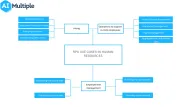HR Process Automation: 7 Benefits & 6 Use Cases in 2024
It is estimated that 25% of capital spending will be devoted to automated systems for the next five years.1 Human resources automation has come a long way in recent years, transforming how businesses manage their most valuable asset – their employees. This game-changing technology offers many benefits, from streamlining processes to reducing costs.
This article will explore the top 7 HR process automation benefits organizations should consider when optimizing workforce management and the top use cases of automating HR tasks.
Top 7 HR process automation benefits
HR automation software is a powerful tool that can revolutionize workforce management, offering numerous benefits for organizations of all sizes. Here we list the top 7 benefits of HR automation:
1- Guarantees information security compliance and data integrity
Automating HR processes help keep your forms, documents, workflows, and signatures in one place. This guarantees information security compliance and preserves data integrity, minimizing the risk of errors and unauthorized access to sensitive information.
2- Improves recruitment and onboarding processes
HR automation software streamlines the entire recruitment and onboarding process, enabling organizations to identify top talent quickly and efficiently. Automation tools can handle processes such as:
- Posting job ads
- Screening resumes
- Scheduling interviews
- Managing onboarding tasks.
This helps ensure a seamless experience for both candidates and HR professionals.
3- Reduces payroll errors
HR automation tools can significantly reduce the risk of errors in payroll processes, such as incorrect calculations, duplicate payments, or missed deadlines. Automation software helps ensure accurate and timely payroll processing, leading to improved employee satisfaction and reduced administrative burden.
4- Increases efficiency
~60% of executives state that they use AI to improve consistency and quality in their work. By automating repetitive tasks, HR automation software frees time for HR professionals to focus on strategic, high-value initiatives.2 This improved efficiency leads to better resource allocation, ultimately driving organizational success.
5- Fosters communication and collaboration among the team
HR automation software simplifies communication and collaboration among HR teams, enabling them to share information, track progress, and coordinate efforts easily. These tools can facilitate real-time updates, notifications, and reminders, leading to a more informed and engaged workforce.
6- Reduces paper-based processing costs
Transitioning to digital, automated processes significantly reduces the costs associated with paper-based processing, such as printing, storage, and manual data entry in HR departments. By eliminating these expenses, organizations can redirect their resources towards more strategic investments, such as employee development or technological advancements.
7- Enhances employee experience
As your business grows, expands, or changes, HR automation software can easily accommodate these fluctuations by:
- streamlining workflows
- managing increased workloads
- integrating with other systems as needed.
This adaptability ensures that your HR employees remain responsive and able to support the evolving needs of your organization without compromising on efficiency or performance.
For those interested, here is our article on employee sentiment analysis.
Which HR processes can be improved with automation?
Source: KPMG
Figure 1. Assessment of HR tasks on complexity and value added to the company
1- Employee onboarding: Automation can streamline the employee onboarding process by creating digital checklists, automating form completion, and tracking the progress of new hires. This ensures a consistent onboarding experience for all employees and reduces the administrative burden on the HR team.
2- Employee records and data management: Store employee data automatically, such as employment contracts, training records, and performance evaluations. This makes it easy to retrieve and update information as needed and reduces the risk of human errors.
3- Employee performance tracking: Automated performance tracking tools can generate regular performance reports, set reminders for review meetings, and suggest personalized development plans based on employee strengths and weaknesses.
4- Payroll and benefits: Automated HR workflows can integrate with time-tracking tools to calculate overtime pay or apply location-specific tax rates for remote employees.
5- Paid leave management: Automated leave management systems can send notifications for pending requests, auto-approve leave based on predefined rules, and generate real-time reports on leave usage and trends.
6- Data analysis and decision-making: HR automation software can analyze data on employee demographics, turnover rates, and skill gaps, enabling HR professionals to develop targeted recruitment and retention strategies.
If you need assistance in automating HR processes, we can help:
External Links
- 1. “Unlocking the industrial potential of robotics and automation.” McKinsey. January 6, 2023. Retrieved March 25, 2023.
- 2. “2020 Deloitte Global Human Capital Trends.” (PDF). Retrieved March 25, 2023.

Cem has been the principal analyst at AIMultiple since 2017. AIMultiple informs hundreds of thousands of businesses (as per similarWeb) including 60% of Fortune 500 every month.
Cem's work has been cited by leading global publications including Business Insider, Forbes, Washington Post, global firms like Deloitte, HPE, NGOs like World Economic Forum and supranational organizations like European Commission. You can see more reputable companies and media that referenced AIMultiple.
Throughout his career, Cem served as a tech consultant, tech buyer and tech entrepreneur. He advised businesses on their enterprise software, automation, cloud, AI / ML and other technology related decisions at McKinsey & Company and Altman Solon for more than a decade. He also published a McKinsey report on digitalization.
He led technology strategy and procurement of a telco while reporting to the CEO. He has also led commercial growth of deep tech company Hypatos that reached a 7 digit annual recurring revenue and a 9 digit valuation from 0 within 2 years. Cem's work in Hypatos was covered by leading technology publications like TechCrunch and Business Insider.
Cem regularly speaks at international technology conferences. He graduated from Bogazici University as a computer engineer and holds an MBA from Columbia Business School.
To stay up-to-date on B2B tech & accelerate your enterprise:
Follow on
![AI in HR: In-depth guide with top use cases [2024]](https://research.aimultiple.com/wp-content/uploads/2017/08/top-hr-usecases-190x143.png.webp)
Comments
Your email address will not be published. All fields are required.